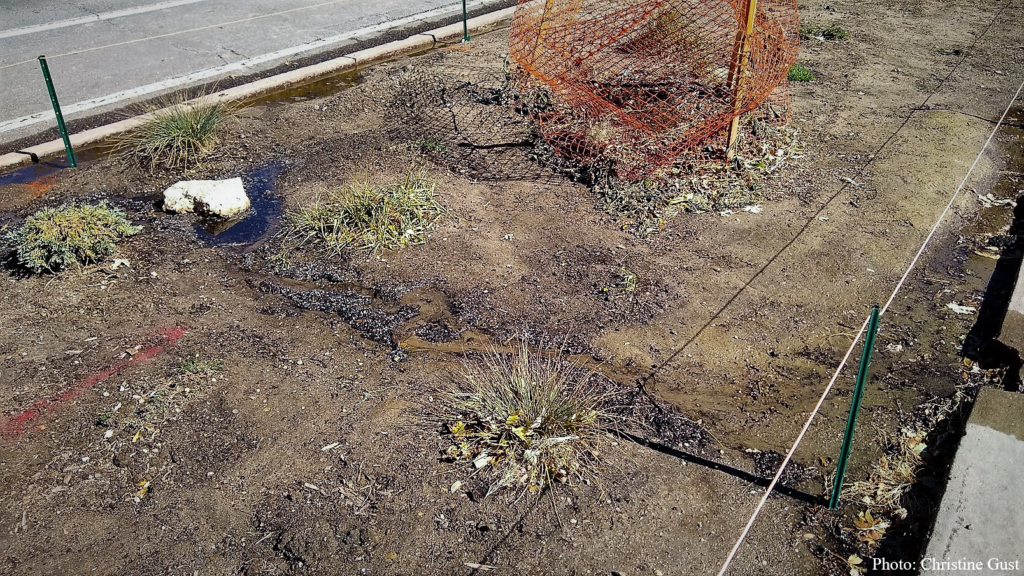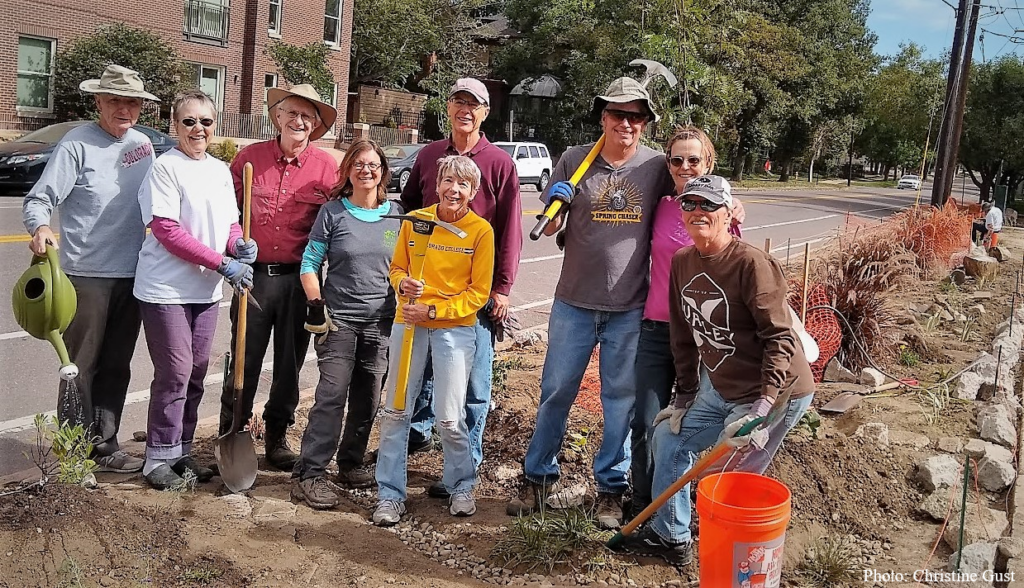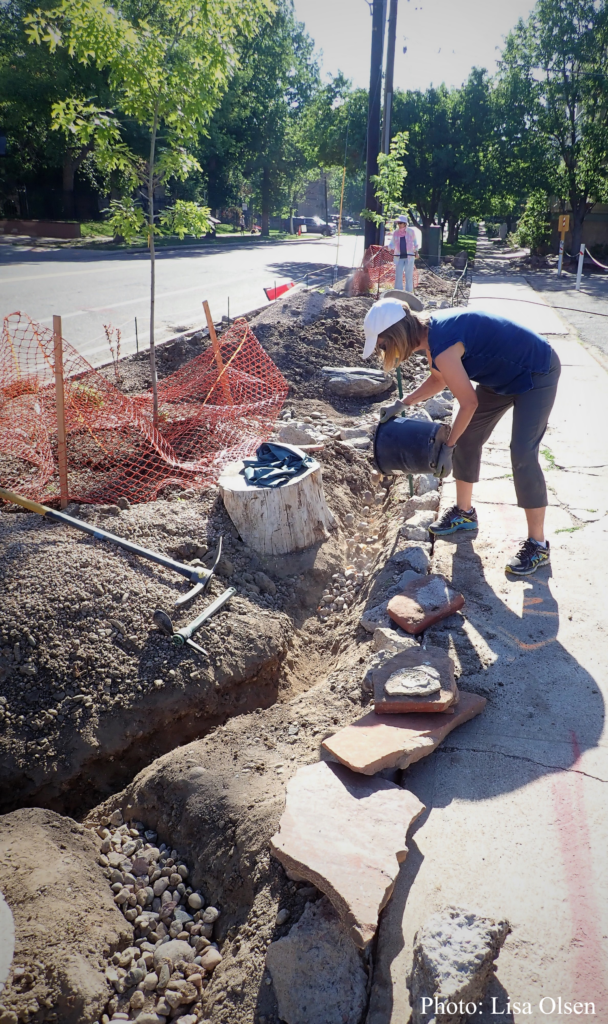By Lisa Olsen
Residents of the North Capitol Hill neighborhood in Denver have noticed a lot of activity at the Denver Turnverein. Founded in 1865, the Denver Turnverein is a member-supported non-profit focused on the educational, social, and physical benefits of dancing. Built in 1920, Denver’s premier dance hall is celebrating its hundredth anniversary this year. Under normal circumstances, the building would be filled every night with lively music and a welcoming community of dancers. In the age of COVID-19, the Turnverein building is quiet. But the Greenverein Garden, on the north side of the property, is teeming with life.
The Greenverein Garden was proposed by volunteers from Uptown on the Hill, a community organization that connects residents and businesses and works toward improving the livability of the North Capitol Hill neighborhood. They saw an opportunity to “green” and beautify the neighborhood by transforming the ugly asphalt-covered strip at the corner of 16th Street and Clarkson to a low-maintenance landscape that would be enjoyed by residents and visitors. Late in 2018, in collaboration with the Denver Turnverein Board President, fundraising began in earnest, resulting in financial support from former City Council member Wayne New, a grant from the Colorado Cactus and Succulent Society, and individual donations to a GoFundMe account. In Spring of 2019, contractors removed the asphalt, and three street trees, donated by The Park People, were planted. In June of 2019, volunteers planted an assortment of low-water shrubs, perennials and grasses, including Japanese Barberry, Blue Rug Juniper, Russian Sage, Sedum, Ice Plant, Iris, and Daylilies, all tried and true plants for Colorado gardens. The native soil is heavily compacted clay; volunteers resorted to pickaxes in order to break up the ground. Christine Gust, a member of both the Turnverein and Wild Ones and schooled in permaculture, volunteered on planting day, and thought that the garden would be a welcome home to some native plants that would be better suited to the garden’s challenging conditions. The Greenverein Garden is the epitome of a hellstrip: sandwiched between an asphalt parking lot and a street, in full sun, with lifeless, compacted, dry, poor soil and extreme heat. The summer of 2019 was relentlessly hot; dedicated volunteers worked valiantly to keep the garden alive, hand-watering the plants almost every day. Then, in August, a torrential downpour brought disaster: Clarkson and 16th swelled with stormwater, submerging the garden and washing away much of the soil around the plants.

In early September, Christine arranged a meeting between volunteers from the Denver Turnverein, Uptown on the Hill and Wild Ones Front Range Chapter Board Members to discuss goals for the garden and potential steps forward. Wild Ones elected to invest time and resources into this project because of its very public location, its grassroots support, and its potential as a demonstration garden. When outlining the goals of the Greenverein Garden, aesthetic appeal topped the list. The initial intent of the garden was to beautify the neighborhood: the garden needs to be pretty and offer year-round interest. In practical terms, the garden must be low cost: most of the funds raised had been spent, and the water budget for the Turnverein is tight. The garden needs to be low maintenance: while regular watering and weeding of the seed bank is expected to establish plants, in the long term the garden needs to be xeric, requiring infrequent watering, occasional weeding and seasonal maintenance. It needs to be functional: volunteers need access for maintenance, but the design should discourage jaywalkers from cutting through and dogs from doing their business. Counseled by Wild Ones, pivoting to a predominantly native plant palette in the garden fulfills all of the above criteria, while boosting its ecological value. Selecting native plants that will thrive under the challenging conditions not only makes the garden more resilient, but it also makes it more inviting for our native bees, butterflies, birds and other wildlife.
The biggest blessing and curse of the Greenverein Garden is water. With no installed irrigation system, the garden relies entirely on manual watering with a hose that is pulled from storage and connected to a hose bib each time the garden is watered. Under these circumstances, rain would be welcome. But given the vast area of the Turnverein’s roof (it’s a dance hall) combined with the adjacent impermeable parking lot, the potential volume of water sheeting across the garden and eroding the soil is great. Even a moderate shower could do significant damage. Lisa Olsen (currently Wild Ones Front Range Chapter President) suggested that altering the topography of the garden could enhance its potential to both capture rainwater and mitigate soil erosion. Check dams installed adjacent to the sidewalk and the street would slow the flow of water into and out of the garden, and a network of trenches of varying depths filled with rock (essentially French drains without the pipes) would both slow and direct the flow of water through the garden, giving it time to infiltrate. Lisa learned about water harvesting from Brad Lancaster at a week-long ecological design workshop hosted by the Woodbine Ecology Center several years ago and had seen garden installations designed to harvest water in California, New Mexico and Colorado. She hadn’t actually designed one but was willing to try. With winter on the horizon, volunteers, organized by Christine as project manager, agreed to move forward with a redesign and planting of the western third of the garden, to test the design’s feasibility, viability and appeal.

In late September, volunteers took up pickaxes and shovels and got to work, digging trenches, building berms and “planting” urbanite. Given the inner-city location, the initial intention of expanding the neighborhood’s “green” footprint, and the tight budget, it was determined that urbanite — chunks of broken concrete — would serve as the primary hardscape element in the garden. Cement, the key ingredient of concrete, has a massive carbon footprint (8% of the world’s carbon dioxide (CO2) emissions); sourcing concrete locally (a material that is readily available in a city) compounded the garden’s potential to sequester carbon and help mitigate the effects of climate change. In addition to recycling urbanite, volunteers collected free boulders, river rock, cobbles, squeegee, pea gravel and weathered cottonwood stumps off of Nextdoor and Craigslist. Donors were excited to learn about the project and to see their unwanted materials put to good use. Volunteers dug up the plants that had survived the summer heat; some were transplanted into the new berms and others were potted up and tended over the winter. With limited funds, a handful of shrubs and perennials were purchased at local nurseries, and other native plants were donated by Wild Ones members, including Arthur Clifford, Jan Midgley, and Betty Jo Page. Almost all of the plants that were planted last October survived the winter; those that are thriving this summer include Colorado native Blue Flax (Linum lewisii), Dwarf Rabbitbrush (Chrysothamnus nauseosus var. nauseosus), Swamp Milkweed (Asclepias incarnata), Butterfly Weed (Asclepias tuberosa), and Prairie Sage (Artemisia ludoviciana), and regionally native Red Birds in a Tree (Scrophularia macrantha) and Desert Beardtongue (Penstemon pseudospectabilis; it bloomed heavily in the spring and rebloomed in July). Only one of the three street trees that were planted in the spring of 2019 survived the summer; two replacement trees were planted in November by folks from Denver’s City Forestry “Be a Smart Ash” program. The city originally offered to plant a Hardy Rubber Tree and a State Street Maple, both native to Asia; a letter from Wild Ones asking for trees more in line with the garden’s goal of supporting wildlife yielded substitutions of North American native Honeylocust (Gleditsia triacanthos var. inermis ‘Skycole’ Skyline®) and Scarlet Oak (Quercus coccinea). All three trees were wrapped to guard against sunscald and watered as needed through the winter: all three leafed out vigorously in the spring, after April’s untimely freeze.

The success of the pilot phase encouraged an expansion of the design. In spite of, and in some cases because of the COVID-19 pandemic, volunteers made rapid progress. Materials were more readily available (as many who were stuck at home undertook yard improvement projects) and volunteers whose work schedules were disrupted had more time to dedicate towards installation. Following the lifting of the “stay at home” order, volunteers donned masks and showed up to work — at safe distances — in the garden. At times it felt a bit like we were building a plane while in the air, incorporating materials and plants as they became available. Not everything was installed in the ideal order: some berms were planted before they were reinforced with urbanite, plants that were impossible to get in the spring were easily sourced in the heat of summer, and a few trenches remain to be dug after berms are complete, resulting in surplus soil. Spring brought successful applications for two microgrants (from Capitol Hill United Neighborhoods and the Community Active Living Coalition); these funds covered the cost of plants from local nurseries and when combined with donations of materials and labor courtesy of George Rock IV and the Bank of Denver, donated shrubs from Fort Collins Wholesale Nursery, donated plants from Wild Ones members and donated cacti from Rod Haenni and other CCSS enthusiasts, the garden sprang to life. As expected, a few plants struggled and succumbed to the heat (it’s never optimal to plant a garden in July), but many thrived, including the Great Basin/Big Sagebrush (Artemisia tridentata), Cliff Fendlerbush (Fendlera rupicola), and Fringed Sage (Artemisia frigida). The Blanket Flower (Gaillardia aristata) and the Rocky Mountain Bee Plant (Cleome serrulata) completely ignored the “sleep, creep, leap” adage and are blooming profusely. Top marks go to one particular Desert Four O’Clock (Mirabilis multiflora), a transplanted seedling from John Murgel’s garden (John hosted a Wild Ones tour last fall). The volunteer who planted it thought she had killed it as most of the foliage snapped off while planting; apparently the plant took that setback as a personal challenge and sprang out of the ground, perfectly content with the sun, the heat and the poor soil.

Research indicates that a connection to nature is essential to human health, that spending time in nature yields significant benefits to our physical, mental and emotional well-being. Having a garden that’s close to home, a place to get hands dirty and unplug mentally, is important under normal circumstances; for those living under the stress of a pandemic, it becomes vital. Garden volunteers, most of whom are senior women, welcome the break from isolation and the opportunity for physical exertion and social connection that the garden provides. In a public space, safety is always a concern, and volunteers arrange to meet in pairs or small groups. For several days in June, groups worked in the garden beneath the constant drone of helicopters that were monitoring the situation in downtown Denver. A mere six blocks from the state capitol, the garden is situated on a pedestrian thoroughfare, with the adjacent street closed to through traffic to allow Denverites more space to exercise safely. Volunteers for whom joining a peaceful protest was too great a health risk, felt that they were showing support for their community by building something beautiful, and by heralding protesters bearing signs as they passed and thanking the volunteer crews that patrolled the streets each morning collecting the detritus from the previous night. Environmental degradation in many neighborhoods is in part the result of the systemic oppression of communities of color in this country. Transforming an asphalt wasteland to a vibrant garden shines a light on what’s possible as we face this societal reckoning and look for ways to move forward and make enduring changes in underserved communities.

While it is difficult to build ideal habitat adjacent to a city street, certain elements, like host plants, go a long way towards inviting wildlife to visit, and possibly reproduce. The cottonwood stumps were introduced into the design as both aesthetic and ecological features. Cottonwoods are native keystone species of riparian corridors on the plains, but they are a poor choice for urban settings. “Planting” cottonwood stumps in the garden honors their immense ecological value without the mess and hazard of living trees. Placed near milkweed and other host plants, the cracks and crevices in the dead wood provide shelter for caterpillars to pupate. Our hope is to foster youth and adult engagement with nature in the garden through Citizen Science programs like Native Bee Watch and the Monarch Larva Monitoring Project.
It’s always best to select the “right plant for the right place”, to select plants for the soil and exposure that you have rather than altering the soil by tilling or amending and stressing plants unnecessarily. In order to optimize the Greenverein Garden’s ability to conserve water and build soil over time, relatively minor adjustments to the topography were deemed necessary. While composed mostly of native clay, the low berms, some amended with looser fill dirt and pea gravel, provide sufficient drainage for cacti and other plants like Penstemons that are accustomed to growing on slopes. The berms’ added height enabled the addition of small sections of crevice gardens, which will showcase diminutive cacti, succulents, and heat-tolerant rock garden plants. While working in the garden, the feedback expressed by passersby to volunteers has been refreshingly positive; people love how the garden looks like Colorado, how it reflects this state’s exceptional rugged beauty. It’s hard not to laugh when people say, “I can’t wait to see how it looks when it’s done.” That’s not how gardens work. Gardens are alive, ever-changing. Plants sometimes thrive, sometimes fail, and there is (almost) always room for more. Cultural landscape historian and writer Mac Griswold describes gardening as “the slowest of the performing arts.” As such, the Greenverein Garden fulfills the Turnverein’s mission to showcase and promote the practice and performance of the arts — those that maintain a sound body and mind — and is a beautiful and fitting addition to the North Capitol Hill neighborhood.

If you live nearby and are interested in volunteering to help maintain the garden, please send an email to [email protected] and we will contact you about scheduled work days. If you would like to support the garden financially, please consider making a donation to the GoFundMe account. Funds raised will go towards adding to and diversifying the garden’s plant palette (at last count we are at 124 species, 73% of which are regionally native; we hope to boost both numbers as temperatures cool and more plants become available) and incorporating plant labels and educational signage. Check out the garden in person at 1570 N. Clarkson Street, in downtown Denver.

Curious to learn more about transforming your garden into a habitat with Colorado native wildflowers, grasses, shrubs, and trees? Check out our native gardening toolkit, register for an upcoming event, subscribe to our newsletter, and/or become a member – if you’re not one already!
